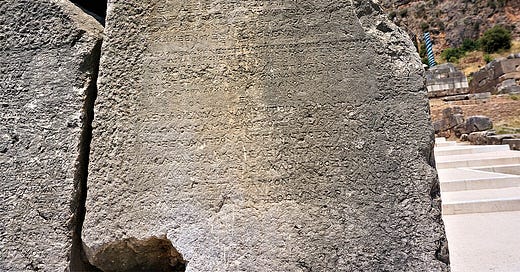Paths to Freedom: Manumission of Enslaved Persons
Pathways to freedom for enslaved persons in ancient Greece.
Today in the United States we celebrate the national holiday of Juneteenth (officially Juneteenth National Independence Day) it commemorates the ending of slavery in the United States. While president Abraham Lincoln had issued the Emancipation Proclamation on January 1, 1863 - the enforcement of emancipation was largely dependent on the presence and power of Union troops. Texas, being one of the most remote Confederate states, continued the practice of slavery until General Granger’s announcement of General Order No. 3 when he arrived in Texas on June 19, 1865.
I thought it would be a fitting time to discusses enslavement in ancient Greece and talk about the concept of manumission, or the process by which enslaved individuals could gain their freedom. In the United States manumission was far less common in the American South compared to ancient Greece. Legal and social barriers made it difficult for enslaved persons to gain freedom, and even freed African Americans faced severe legal and social discrimination, with very limited rights and opportunities.
Pathways to freedom in ancient Greece included the following:
Consecration to a God
Enslaved persons could be dedicated to a deity, becoming sacred (hieros) and thereby free from human ownership. Known as "fictive consecration," this practice implied that the enslaved person became the property of the God. Documented in places like Chaeronea and Bouthrotos, this method offered a religious and legal avenue to freedom. While consecrated individuals were technically free, their lives were still closely tied to the religious institution. This integration into the religious community offered a form of social security and status, although they remained distinct from fully free citizens.

Sale to a God
Similar to consecration, the sale to a God involved the enslaved person being sold to a deity. In this practice, the enslaved person would gather the necessary funds, often with the help of family, friends, or even through their own savings. The enslaved person would entrust the money to the temple officials. This money symbolically represented the price paid to the deity for the person’s freedom. The act of giving the money to the temple formalized the transaction in the eyes of both the religious and civic authorities. Once the money was handed over, the temple officials would document the transaction. This documentation served as a legal record of the manumission. Inscriptions or written records were often made on stone steles or bronze tablets and placed in or around the temple precincts. These records typically included the names of the enslaved person, the deity, and sometimes the former owner. Roughly one thousand Greek inscriptions have been found at Delphi, recording the manumission of enslaved persons between 200 B.C.E and 100 C.E.
Verbal Manumission
One of the simplest and most direct forms of manumission in ancient Greece was a verbal declaration by the ensalver. The ensalver could simply announce that the enslaved person was free. This straightforward method is often referenced in literary sources, particularly in Attic oratory. The verbal declaration symbolized an immediate and public acknowledgment of the enslaved person's change in status.
Manumission by Will
Ensalvers could include provisions in their wills to free their slaves upon their death. This practice is well-documented and provides some of the most concrete evidence of manumission in ancient Greece. For instance, the "wills of the philosophers," recorded by the biographer Diogenes Laertius in the second century CE, detail several instances where philosophers granted freedom to their enslaved persons posthumously.
State Intervention
Political authorities sometimes played a crucial role in the emancipation of enslaved persons. In ancient Greece, a notable example occurred during the naval battle at Arginousai in 406 BCE when Athens freed slaves and granted them citizenship to bolster their naval forces due to a shortage of manpower.
Public Manumission
Public declarations of manumission were another method used to free enslaved persons. These declarations could take place in significant public spaces, such as the Theater of Dionysus in Athens. Although the exact nature of these declarations—whether they were performative acts of freeing the enslaved person or simply announcements of previously conducted manumissions—remains unclear, the public nature of the act reinforced the legitimacy and recognition of the new status.
Sale for Freedom
A more complex method was the "Prasis Ep’ Eleutheriai," or sale for freedom. This involved a real or fictive sale of an enslaved person from one owner to another with the explicit purpose of setting them free. Often, a third party would pay for the enslaved person’s freedom, facilitating the process and ensuring that the former owner was compensated.
As we reflect on these paths to freedom, it is important to recognize the enduring spirit of those who fought against their bondage, striving for a life of autonomy and dignity against difficult odds. In conjunction with the Juneteenth celebration, it is also important to reflect on the progress made and the work still needed to achieve true equality.





